
Acacia nigricans is a species of wattle which is endemic to an area on the south coast of Western Australia.
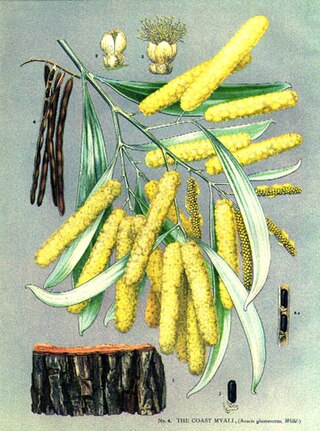
Acacia binervia, commonly known as the coast myall, is a wattle native to New South Wales and Victoria. It can grow as a shrub or as a tree reaching 16 m in height. This plant is reportedly toxic to livestock as the foliage (phyllodes) contain a glucoside which can produce hydrogen cyanide if cut.
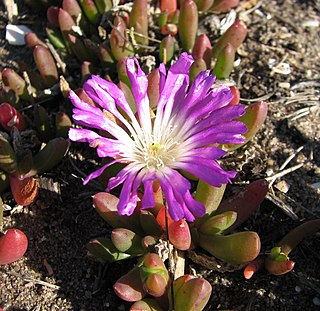
Disphyma crassifolium subsp. clavellatum is the subspecies of Disphyma crassifolium that occurs in Australia and New Zealand. It is sometimes known by the common name rounded noon-flower

Amyema miquelii, also known as box mistletoe, is a species of flowering plant, an epiphytic hemiparasitic plant of the family Loranthaceae, found attached to several species of Australian eucalypt and occasionally on some species of Acacia. It is the most widespread of the Australian Mistletoes, occurring mainly to the west of the Great Dividing Range. It has shiny leaves and red flowers arranged in groups of 3. It is distinguished from the similar Amyema pendula through the individual stalks of the flowers.

Acacia moirii, commonly known as Moir's wattle, is a subshrub which is endemic to the south-west of Western Australia. It grows to between 0.15 and 0.6 metres high and has densely hairy leaflets. The globular golden-yellow flower heads appear from May to August, followed by hairy seed pods which are around 4 cm long and 5 to 6 mm wide.

Acacia farinosa, commonly known as mealy wattle, is a shrub that is endemic to Australia. It grows to between 1 and 2 metres high and has ascending phyllodes. The yellow globular flower heads generally appear between August and October in its native range. These are followed by curled and twisted pods which are up to 6 cm long and 2–3 mm wide.
Thomas Hoy was an English gardener and botanist employed by the Duke of Northumberland at Syon House in Middlesex in the United Kingdom, a position he held for 40 years. Described as "an experienced botanist and able cultivator" he became a fellow of the Linnean Society of London in 1788 and presented a number of flowering plants to the society from which several species were first formally described including the Australian plants Acacia suaveolens, Acacia myrtifolia and Goodenia ovata.
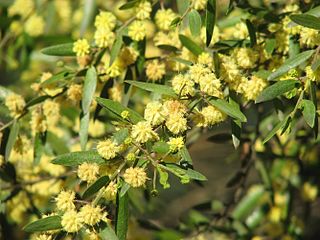
Acacia verniciflua, commonly known as varnish wattle, is a shrub or small tree species that is endemic to Australia. The species occurs in dry sclerophyll forest in South Australia, Victoria, New South Wales and Queensland. It is often found growing alongside Eucalyptus obliqua where it can dominate the understory.

Acacia howittii, commonly known as sticky wattle or Howitt's wattle, is a tree species that is endemic to Victoria, Australia.
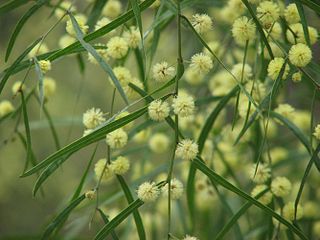
Acacia stictophylla, also known as Dandenong Range cinnamon wattle, is a species of Acacia that is endemic to Victoria, Australia. The species was first formally described in the botanical journal Muelleria in 2009. Previous to this it was included in the species Acacia leprosa and was often referred to as the "Dandenong Range variant". It is listed as "Rare in Victoria" on the Department of Sustainability and Environment's Advisory List of Rare Or Threatened Plants In Victoria.

Acacia mitchellii, commonly known as Mitchell's wattle, is an erect or spreading shrub which is endemic to Australia. It grows to up to 2 metres high and has small bipinnate leaves. The pale yellow globular flowerheads appear in groups of 1 to 3 in the axils of the phyllodes followed by straight or curved seed pods which are 1.8 to 5 cm long and 4 to 8 mm wide.

Acacia aspera, commonly known as rough wattle, is a spreading shrub which is endemic to south-eastern Australia. It grows to up to 2 metres high and has phyllodes which are 10 to 30 mm long and 2 –4 mm wide. The pale yellow to gold globular flowerheads appear singly or in groups of two in the axils of the phyllodes in July to September, followed by curved or coiled seed pods which are 20 to 70 mm long and 3 to 5 mm wide.

Acacia rostriformis, commonly known as Bacchus Marsh wattle, is a plant species that is endemic to Australia. It was first formally described in 2009 in the journal Muelleria.

Acacia montana, commonly known as mallee wattle, is a shrub species endemic to south-eastern Australia. The species was first formally described in 1842 by English botanist George Bentham from plant material collected from the "highlands near the Liverpool Plains" in New South Wales. The Latin specific epithet montana refers to mountains or coming from mountains.

Amyema congener, commonly known as the variable mistletoe, is a species of flowering plant, an epiphytic hemiparasitic plant of the family Loranthaceae from eastern Australia. It is found on members of the genera Allocasuarina, Acacia and some exotic species.

Acacia ausfeldii, commonly known as Ausfeld's wattle or whipstick cinnamon wattle, is a shrub species that is endemic to south-eastern Australia. It grows to between 1 and 4 metres high and has phyllodes that are 2 to 7 cm long and 2 to 6 mm wide. The yellow globular flowerheads appear in groups of two or three in the axils of the phyllodes in August to October, followed by straight seed pods which are 4 to 9 cm long and 2 to 4 mm wide.
Mount Wellington is a mountain located to the north-east of Licola in Victoria, Australia. It is on the border of the Alpine National Park and Avon Wilderness Park. The Avon River rises on its south-eastern slopes.
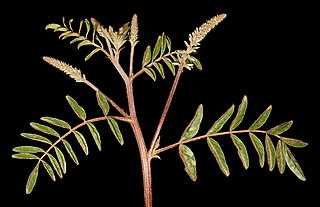
Glycyrrhiza acanthocarpa, with the common names native liquorice, and southern liquorice is a subshrub in the pea family, Fabaceae. The species is native to Australia. It grows to between 0.1 and 1 metre high. Narrow purple flowers appear between September and May in the species native range.

Denhamia oleaster is a shrub or small tree within the family Celastraceae, endemic to Queensland. The species inhabits a variety of environments, from monsoon forest to semi-arid savanna and occurs on a broad range of soil types. In more humid locales the species can grow to 6 metres in height, although it may not reach more than 1 metre in less favourable environments.

Acacia ulicifolia, commonly known as prickly Moses or juniper wattle is a shrub of the genus Acacia and the subgenus Phyllodineae, native to Australia.


















